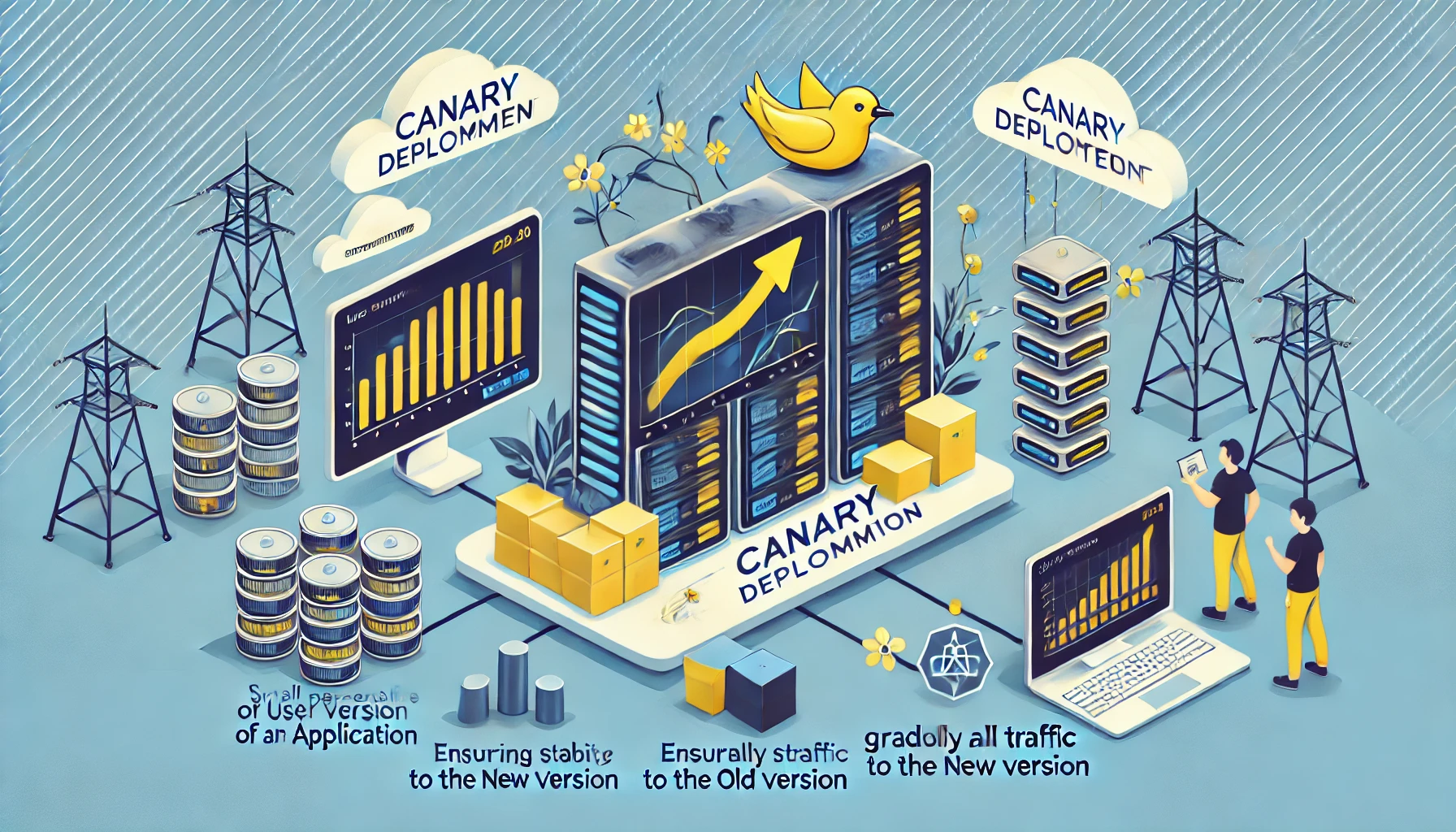Mastering Kubernetes: Containers, Deployment Strategies, and Best Practices
Understanding the Fundamentals: Containers and Kubernetes :-
- Before diving into the advanced deployment strategies, let's ensure we're on the same page with the basics. Understanding containers and Kubernetes is crucial to grasping the power and elegance of these advanced techniques.
What are Containers?
- Containers are lightweight, standalone executable packages that include everything an application needs to run: code, runtime, system tools, system libraries, and settings. Think of them as self-contained units, isolating applications from the underlying infrastructure. This isolation ensures consistency and portability across different environments, whether it's your local machine, a cloud provider, or a bare-metal server. Popular containerization technologies include Docker, which simplifies the process of creating, deploying, and managing containers.
- Containers enhance application portability by abstracting the underlying operating system. This means that an application packaged as a container can run seamlessly on any system that supports the container runtime, without the need for extensive configuration or compatibility adjustments. This portability is a cornerstone of modern cloud-native application development.
What is Kubernetes?
- Kubernetes, often abbreviated as K8s, is an open-source container orchestration platform. It automates the deployment, scaling, and management of containerized applications. Think of it as a sophisticated control system for your containerized applications, managing their lifecycle and ensuring their availability and scalability. Kubernetes excels at handling complex deployments involving numerous containers, automating tasks like load balancing, health checks, and rolling updates.
- Kubernetes provides a robust and scalable framework for managing containers across clusters of machines. It handles tasks like scheduling containers, managing resources, and ensuring high availability. The ability to seamlessly scale applications up or down based on demand is a key advantage of using Kubernetes. Without Kubernetes, managing a large number of containers across multiple servers would be an extremely challenging and error-prone process.
Why Kubernetes and Containers Together?
- The combination of containers and Kubernetes is a powerful synergy. Containers provide the packaging and portability, while Kubernetes provides the orchestration and management. This combined approach simplifies application deployment, scaling, and maintenance, streamlining the entire DevOps lifecycle. The advantages are numerous, including improved efficiency, better resource utilization, and increased scalability and resilience.
- This pairing is the backbone of modern cloud-native architectures. Organizations are increasingly adopting this approach for its efficiency and scalability benefits, especially in microservice-based applications, where managing numerous independent services requires a robust orchestration layer like Kubernetes.
Advanced Deployment Strategies in Kubernetes :-
Now that we've established the fundamentals, let's explore some advanced Kubernetes deployment strategies designed to minimize downtime and ensure a smooth application update process.
Blue-Green Deployments :-
- In a blue-green deployment, you maintain two identical environments: a 'blue' environment (live) and a 'green' environment (staging). You deploy the new version of your application to the green environment, thoroughly test it, and then switch traffic from the blue to the green environment. If something goes wrong, you can quickly switch back to the blue environment with minimal disruption.
- This strategy minimizes downtime and risk because the new version is tested in a completely isolated environment before being exposed to live traffic. Switching between environments is typically handled through configuration changes in a load balancer or ingress controller. Blue-green deployments are effective for applications with high availability requirements, reducing the impact of potential deployment issues on end-users.
Canary Deployments
- Canary deployments gradually roll out a new version to a small subset of users. This allows you to monitor the performance and stability of the new version in a real-world setting before fully deploying it to all users. If issues arise, you can quickly roll back the deployment to the previous version without affecting the majority of users.
- This approach reduces the risk associated with deploying new code by allowing for incremental rollout and real-time monitoring. By monitoring key metrics like error rates and latency, you can identify and address any problems before they impact a larger user base. Canary deployments are particularly beneficial for applications where even minor downtime can have significant consequences.
Rolling Updates
- Rolling updates gradually replace older instances with newer ones, one at a time. This ensures that the application remains available throughout the update process, with minimal downtime. Kubernetes handles the process of updating each pod individually, ensuring a smooth transition.
- This strategy offers a balance between minimizing downtime and reducing risk. Unlike blue-green deployments, it doesn't require maintaining two identical environments. It's a more efficient use of resources, but requires careful monitoring during the update process to ensure no unforeseen issues arise.
Recreate Deployments
- In a recreate deployment, Kubernetes terminates all existing pods before creating new ones with the updated image. This is a simple approach, but it results in complete downtime during the update. This method is generally less preferred due to the downtime incurred, but is suitable for applications with shorter downtime windows or less stringent availability requirements.
- While simple to implement, recreate deployments should be used with caution, as any issues in the updated deployment will result in complete application unavailability until the issues are resolved. Alternatives that minimize downtime are generally preferable for most applications.
Advanced Concepts and Best Practices
- Mastering Kubernetes also involves understanding more complex deployment patterns and best practices.
StatefulSets
- StatefulSets are designed for applications requiring persistent storage and unique network identities for each pod. Unlike deployments, StatefulSets manage pods with persistent storage volumes and stable network identifiers, ideal for databases or other stateful applications.
- StatefulSets address the challenges of deploying stateful applications in a dynamic environment like Kubernetes. They ensure that each pod has a persistent storage volume that survives restarts and scaling events, maintaining its data across updates and failures. This is a key consideration for databases and other applications that cannot afford data loss.
DaemonSets
- DaemonSets ensure that a single instance of a pod runs on every node in a cluster. This is useful for system-level daemons or agents that need to run on every node, like logging agents or monitoring tools. Every node in your cluster will always have a pod from the DaemonSet running on it.
- DaemonSets offer an effective solution for deploying applications that need to run on every node in the cluster to perform system-level tasks. This simplifies deployment of tools that collect information or perform actions on individual nodes within the Kubernetes cluster.
Managing Persistent Volumes
- Persistent Volumes (PVs) provide persistent storage to containers. They abstract the underlying storage mechanisms, allowing you to use different storage providers without modifying your application. This is essential for stateful applications that require data persistence beyond the lifetime of a pod.
- Persistent Volumes and their associated Claims (PVCs) are vital components for ensuring data durability in Kubernetes deployments. This abstraction allows you to change underlying storage solutions without changes to your application configuration, providing flexibility and resilience.
Network Policies
- Network Policies control the communication between pods within a cluster. They provide a layer of security by restricting network traffic based on labels, namespaces, and other criteria, ensuring the security and isolation of your application pods.
- Network Policies provide a crucial level of security and control over the network traffic within a Kubernetes cluster. By defining granular rules, you limit the potential attack surface and enhance security.
Secrets Management
- Secrets, such as passwords, API keys, and certificates, should be stored securely and managed separately from application code. Kubernetes provides mechanisms for managing and distributing secrets securely, preventing hardcoding sensitive information into your applications.
- Proper secrets management is a crucial part of securing your applications. Kubernetes provides features such as Secrets and external secret management tools to ensure that sensitive information is stored and managed properly, reducing the risks associated with exposure of critical data.
Real-World Examples and Use Cases
Let's look at some practical applications of these advanced strategies.
Example: Deploying a Microservice Application
A microservice architecture is composed of many independent services. Kubernetes, with its ability to manage numerous containers, is the perfect platform for such deployments. You might use rolling updates to minimize downtime when updating individual services, ensuring high availability.
Rolling updates, canary deployments, or even blue-green deployments can all be effective approaches to ensure smooth updates in microservice-based systems. This allows you to update and maintain individual services without impacting the entire application.
Example: Scaling a Database with StatefulSets
- Scaling a database requires managing persistent storage and unique network identifiers for each database instance. StatefulSets in Kubernetes perfectly handle this, providing consistent and reliable scaling for your database deployments.
- StatefulSets offer the reliability and predictability necessary for stateful applications like databases. They address the issues of persistent storage and unique identifiers required by such applications, making scaling and management considerably easier.
Troubleshooting and Monitoring
Even with advanced strategies, issues can arise. Effective monitoring and troubleshooting are key.
Common Challenges
- Challenges include resource exhaustion, network issues, and deployment failures. Understanding these challenges and having appropriate monitoring in place is critical for successful Kubernetes deployments.
- Proactive monitoring using tools like Prometheus and Grafana are critical for mitigating risks and avoiding downtime. Understanding common error patterns and their root causes is a crucial skill for any Kubernetes administrator.
Monitoring Tools and Techniques
- Tools like Prometheus and Grafana provide comprehensive monitoring and visualization, enabling proactive identification and resolution of issues. Metrics and logging are fundamental to maintaining application health and stability.
- Robust monitoring is an essential element of any production Kubernetes environment. Regularly review logs and metrics to identify performance issues and potential problems before they affect the user experience. Effective monitoring strategies are key to successful Kubernetes deployments.
Review
Kalpesh Shewale
I am grateful to have completed my Full Stack Development with AI course at Apnaguru. The faculty's support and interactive classes helped me discover my potential and shape a positive future. Their guidance led to my successful placement, and I highly recommend this institute.
Kalpesh Shewale
I am grateful to have completed the Full Stack Development with AI course at Apnaguru. The faculty's dedicated support and hands-on approach during the classes enabled me to unlock my potential and shape a promising future. Their guidance helped me secure a placement with a good package. I highly recommend this course, and for those interested, I also suggest doing the offline version at the center for an enhanced learning experience.

Raveesh Rajput
Completing the Full Stack Development with AI course at Apnaguru was a game-changer for me. I secured an internship through this course, which gave me invaluable hands-on experience. I strongly recommend this course to anyone looking to break into the tech industry. For the best experience, I suggest attending the offline sessions at the center, where the interactive learning environment really enhances the overall experience.

swapnil shinde
Apnaguru’s Full Stack Development with AI course provided me with more than just knowledge—it opened doors to an internship that gave me real-world, hands-on experience. If you're serious about a career in tech, this course is a must. I highly recommend attending the offline sessions for the most immersive and interactive learning experience!
Kalpana Waghmare
I recently completed the Full Stack Developer with AI course on ApnaGuru, and I couldn’t be more impressed! The structure of the course, with well-organized topics and self-assessment MCQs after each section, really helped reinforce my learning. The assignments were particularly valuable, allowing me to apply what I learned in a practical way. Overall, it’s an excellent program that effectively combines full-stack development and AI concepts. Highly recommended for anyone looking to enhance their skills!
Completing the Full Stack Development with AI course at Apnaguru was a pivotal moment in my career. It not only deepened my understanding of cutting-edge technologies but also directly led to an internship that provided practical, real-world experience. If you're aiming to enter the tech field, this course is an excellent stepping stone. I especially recommend attending the in-person sessions at the center, where the dynamic, hands-on learning approach truly maximizes the benefits of the program.

Mahesh Bhosle
I completed the Full Stack Development course at Apnaguru, and it was a valuable experience. The focus on live assignments and projects gave me real-world insights, helping me apply my skills in a professional setting. The interactive live sessions, mock interviews, and question banks were excellent for job preparation. Apnaguru’s company-like environment also helped me get accustomed to real work dynamics. Overall, this course equipped me with the skills and confidence needed for a career in full-stack development. I highly recommend it to anyone seeking hands-on learning and industry relevance.
I recently completed the Full Stack course at ApnaGuru, and I’m genuinely impressed! The curriculum is well-structured, covering both front-end and back-end technologies comprehensively. The instructors are knowledgeable and provide hands-on experience through practical projects. The supportive community and resources available made learning enjoyable and engaging. Overall, it’s a great choice for anyone looking to kickstart a career in web development. Highly recommend!

Adarsh Ovhal
I recently participated in the Full Stack Development With AI Course program, and it has been incredibly beneficial. The guidance I received was tailored to my individual needs, thanks to their advanced use of AI tools. The Trainers were knowledgeable and supportive, helping me explore various educational and career paths. The resources and workshops provided were practical and insightful, making my decision-making process much clearer. Overall, I highly recommend this program to any student looking for IT Field and personalized career guidance!
Shirish Panchal
I’m currently pursuing the Full Stack Developer with AI course at ApnaGuru Training Center, and I'm impressed with what I've experienced so far. The curriculum is well-structured, covering key concepts in both front-end and back-end development, along with AI fundamentals. The instructors are knowledgeable and supportive, which makes it easy to engage and ask questions. I particularly appreciate the hands-on projects that help reinforce what I’m learning. While I’m still in the process of completing the course, I feel that I'm building a strong foundation for my future in tech. I would recommend ApnaGuru to anyone looking to explore full stack development with AI!
Apnaguru Training Center stands out as a top-notch institute for IT education. They provide a wide array of courses, including Full Stack Development, Java Full Stack, Python, Automation Testing, DevOps, and MERN/MEAN Stack, all designed to meet the demands of the modern tech industry.

Mahesh Bhosle
Apnaguru Training Center is a fantastic place for IT education! They offer a variety of courses, including Full Stack Development, Java Full Stack, and Python, all taught by knowledgeable instructors who are committed to student success. The curriculum is up-to-date and includes hands-on projects that enhance learning.
dandewar srikanth
I had an excellent experience with the full-stack web development program at APNAGURU. The instructor had in-depth knowledge of both frontend and backend technologies, which made the concepts easy to grasp. From working on HTML, CSS, JavaScript, and React for the frontend to Node.js and MongoDB for the backend, the learning curve was very smooth.
